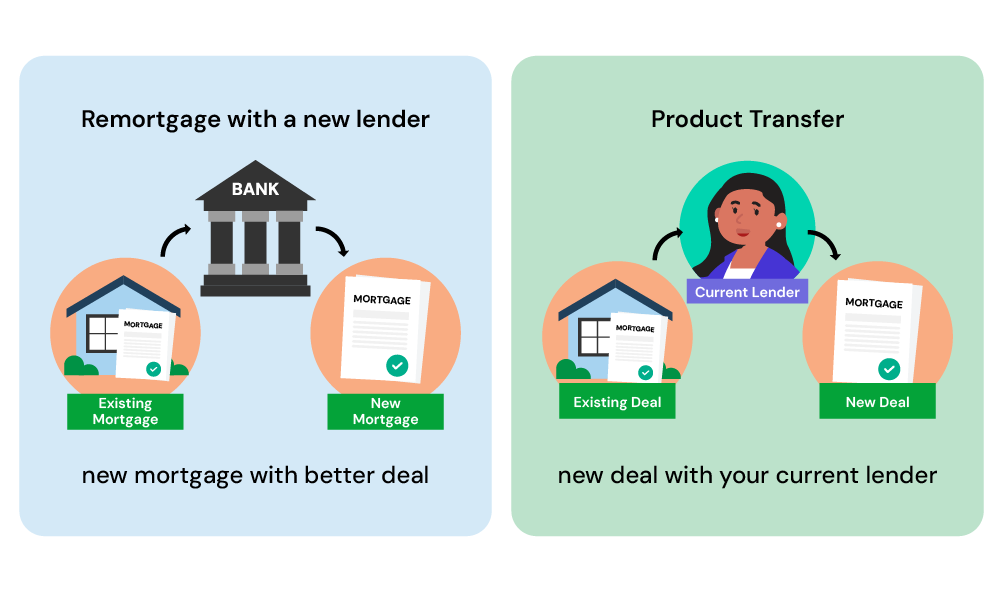- What is a Mortgage Product Transfer?
- How Do Product Transfers Differ from Remortgages?
- What are the Pros and Cons of Product Transfer Mortgages?
- Can You Borrow More During a Transfer?
- How Do Lenders Assess Your Ability to Borrow More?
- Are there Conditions Mortgage Lenders Set for Product Transfers?
- The Bottom Line
How Does Mortgage Product Transfers Work: An In-Depth Guide

Understanding your mortgage options doesn’t have to be a complex ordeal.
If you’re thinking about remortgaging, considering a product transfer with your current lender could be a straightforward and efficient path to explore.
Essentially, a product transfer allows you to modify the terms of your existing mortgage deal without venturing out into the broader market.
While the prospect of altering your mortgage terms might seem daunting, it’s quite the opposite.
A product transfer is a relatively swift process, notably if you’re not planning to borrow additional funds. This option could save you time and potentially reduce the fees associated with a full remortgage.
But remember haste can sometimes make waste.
Before accepting the initial offer from your lender, take a moment to evaluate if a more advantageous interest rate is available elsewhere.
In this comprehensive guide, we aim to shed light on the nuances of product transfers, helping you to weigh the pros and cons, and ultimately, to determine if this is the right path for you.
What is a Mortgage Product Transfer?
A mortgage product transfer is a simple way for you to change your existing mortgage deal with the same lender instead of remortgaging with a different one.
Generally, if you don’t want to borrow more money, this process is swift and doesn’t require a complete valuation of your property.
You won’t have to deal with loads of paperwork or big fees since you’re only adjusting the terms of your existing mortgage. This approach can be a great strategy to save both time and money, helping you keep your mortgage payments affordable and easy to manage.
But be careful – it’s not recommended to quickly accept the first offer your lender gives you. It’s very important to take a bit of time to check if there might be a better interest-rate deal available somewhere else.
Now, if you decide you want to borrow more money during this process, you’ll be venturing into what is called a ‘further advance’.
This is slightly different from a regular transfer, requiring more checks, perhaps a new property valuation, and a bit more paperwork to complete.
Before making any decisions, it’s always a good idea to chat with a mortgage broker. They know the market well and can help you find the best deals available, whether it’s a straightforward transfer or involves a further advance.
Remember, it’s just like looking for a better deal, but for your home loan!
How Do Product Transfers Differ from Remortgages?
A product transfer is, in essence, a kind of remortgage, but it occurs exclusively with your current lender.
On the other hand, remortgaging, as a term, can encompass both changing your mortgage plan with your current lender or switching to a new one altogether.
Now, while these might seem similar, they have some differences you should know about.
First, let’s talk about the time factor. Product transfers are typically quicker than remortgaging with a new lender.
Since you’re sticking with your existing lender, you’re already a step ahead in the process, saving you time on many fronts like paperwork and property valuations. It’s an easier path, especially if you aren’t planning to borrow more money.
But here comes the catch: When you opt for a product transfer, your choices are limited to the mortgage deals that your current lender offers.
In contrast, remortgaging opens up a wider range of options, giving you the freedom to explore offers from different lenders, which might potentially land you a better deal.
So, which one is better? Well, it hinges largely on your circumstances and needs. If you are looking for simplicity and speed, a product transfer could be the way to go.
But, if you don’t mind spending a bit more time to possibly find a more favourable interest rate, remortgaging might be your best bet.
Before making a decision, ensure to have a thorough chat with a mortgage broker to understand the nuances of each option fully. They can guide you to make a choice that aligns perfectly with your financial goals.

What are the Pros and Cons of Product Transfer Mortgages?
Selecting a mortgage product transfer involves careful consideration of both its benefits and potential downsides. Let’s delve deeper to understand the comprehensive pros and cons:
Pros
- Less Legwork. You usually do faceless legwork in a product transfer, making the process more straightforward and less stressful.
- Reduced Paperwork. The product transfer route often involves less paperwork compared to a full remortgage, which could mean fewer headaches for you.
- No Need for Full Valuation. In many cases, a full valuation of the property isn’t required, saving you time and potential fees.
- No Legal Fees. Typically, borrowers are exempt from legal fees during a product transfer, which helps in reducing the initial costs of the process.
- Familiarity with the Lender. Since you are already acquainted with your lender, the process might feel smoother as you understand their system and requirements.
Cons
- Limited Options. You are confined to your current lender’s product range, potentially missing out on more attractive deals available in the broader market.
- Lack of Impartial Advice. Your existing lender may not provide impartial or independent advice, which might limit your insight into possibly better options.
- Approval Challenges. If your financial circumstances have changed, securing approval for a product transfer could prove to be a bit more challenging.
- Potential for Higher Costs in the Long Run. The risk of facing higher costs in the long term is real, especially if you lock yourself into a less favourable deal without exploring other options.
- Increased Risk of Declines. Without the backing of a broker, a decline could turn out to be more costly, leaving you in a precarious financial position.
In short, while product transfers can be quicker and may have lower upfront costs, it’s important to look at them carefully.
Make sure you don’t lock yourself into a bad deal with your current lender without checking if better options are available. This could save you from future financial stress.
Can You Borrow More During a Transfer?
Yes, securing additional funds during a mortgage transfer is a viable option. Just like remortgaging, a product transfer allows you to release some of your home’s equity during the process.
This could be to finance home renovations or to consolidate other debts, and you can initiate this request simultaneously with the transfer.
How Do Lenders Assess Your Ability to Borrow More?
Should you decide to increase the borrowing amount, your lender will undertake a comprehensive evaluation of various factors to determine your eligibility. These include:
- Borrowing Details. Your lender will want to know how much more you are planning to borrow and the reasons for this request.
- Loan-to-Value (LTV) Ratio. It is essential to calculate your existing LTV ratio, which indicates the proportion of your home’s value that is financed through the loan.
- Income and Expenditure Analysis. Your lender will scrutinize your yearly income and monthly expenses to ascertain your repayment capacity with the proposed increased amount.
- Credit Score. A close look at your credit history will provide the lender with a window into your past financial habits and reliability.
After evaluating this information, your lender will measure your requirements against their specific criteria for eligibility and affordability.
Generally, this is calculated as a multiple of your annual income, usually between 4 to 4.5 times.
Consequently, if your additional borrowing doesn’t breach these limits – and other eligibility conditions are met – your application has a good chance of being approved.
Are there Conditions Mortgage Lenders Set for Product Transfers?
Yes, various mortgage lenders impose specific conditions on product transfers. It’s vital to be acquainted with these terms to navigate your options adeptly.
Here, we provide a few examples of the conditions set by different lenders:
- Halifax – Facilitates product transfers either before the expiration of the current agreement or afterwards.
- TSB/Lloyds – Offers product transfers, but they are not available for online processing.
- Nationwide – Coordinates transfers through brokers or their own specialised advisors.
- Santander – Permits transfers within a four-month window before the current agreement concludes.
- Accord – Allows transfers exclusively at the termination of the existing agreement.
- Natwest – Employs in-house advisors to facilitate transfers.
- Birmingham Midshires – Doesn’t charge any fees for product transfers.
- Aldermore – Does not require new credit or affordability checks.
- Yorkshire Building Society – Provides the facility for customers to secure a new deal for up to 120 days.
- Barclays – Extends exclusive rate offers to existing customers.
Remember, while some lenders might offer exclusive perks to their existing customers, it doesn’t guarantee the best deal for you.
Always evaluate various options to make an informed choice.
The Bottom Line
When considering a product transfer, it is not wise to simply accept your current mortgage lender’s offer without exploring other remortgage deals available in the market.
It is highly recommended to consult with a mortgage broker who can scrutinize the entire market for potential offers.
Working with a broker before finalising a remortgage option will open up a wide range of products for you. If the deals offered by your existing lender are indeed the best, your broker will confirm this and advise you to stay with your current mortgage provider.
A skilled broker can help you in a number of ways, including:
- Reviewing and improving your credit reports will increase your chances of securing better rates from other lenders.
- Assisting you with the preparation and organization of essential paperwork, which will smooth the application process.
- Identifying the top mortgage lenders offering the most favourable remortgage rates that match your circumstances.
Contact us to start your smooth journey towards remortgaging. Simply fill out this form to drop your details about your remortgaging goals.
After understanding your needs, we’ll match you with a remortgaging broker ideally suited to help you fulfil your goals.
Get Matched With Your Dream Mortgage Advisor...

Frequently asked questions
How long does mortgage product transfer take?
The time it takes for a mortgage product transfer can vary, but it’s generally quicker than remortgaging with a new lender.
It might take a few weeks, depending on the lender’s processes and your individual circumstances. It is advisable to start the process a few months before your current deal ends to ensure a seamless transition.
What happens when you remortgage?
When you remortgage, you switch your existing mortgage to a new deal, either with your current lender or a different one. This process could help you save money or adapt to changes in your financial circumstances.
What do you need to do for a product transfer?
For a product transfer, you need to review your current mortgage agreement, evaluate the available deals from your current lender, and proceed with the most suitable option. It usually involves less paperwork and is quicker compared to a full remortgage.
What is the meaning of a mortgage product?
A mortgage product refers to the specific type of mortgage deal that you agree upon with your lender. It encompasses the terms, interest rates, and any associated fees.
Is a credit check necessary for product transfers?
While some lenders may not require a credit check for a simple product transfer, especially if your financial circumstances have remained stable, they might conduct one if you intend to borrow a larger sum or if there are significant alterations to your credit report.
Can product transfers be conducted if I availed of the Help to Buy scheme?
Absolutely. Engaging in a product transfer is viable even if your initial mortgage was secured through the Help to Buy scheme.
Regardless of whether you’re sticking with your present lender or opting for a new one, the process doesn’t differ much from standard remortgages. Note that your equity loan will continue to be effective as you enter the new mortgage agreement.
This article has been fact checked
This article was created, checked, and verified by the expert team at Money Saving Guru. Trust us, you’re in good hands.




